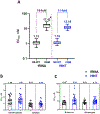An optimized cell-based assay to assess influenza virus replication by measuring neuraminidase activity and its applications for virological surveillance
- PMID: 36332755
- PMCID: PMC10149149
- DOI: 10.1016/j.antiviral.2022.105457
An optimized cell-based assay to assess influenza virus replication by measuring neuraminidase activity and its applications for virological surveillance
Abstract
Year-round virological characterization of circulating epidemic influenza viruses is conducted worldwide to detect the emergence of viruses that may escape pre-existing immunity or acquire resistance to antivirals. High throughput phenotypic assays are needed to complement the sequence-based analysis of circulating viruses and improve pandemic preparedness. The recent entry of a polymerase inhibitor, baloxavir, into the global market further highlighted this need. Here, we optimized a cell-based assay that considerably streamlines antiviral and antigenic testing by replacing lengthy immunostaining and imaging procedures used in current assay with measuring the enzymatic activity of nascent neuraminidase (NA) molecules expressed on the surface of virus-infected cells. For convenience, this new assay was named IRINA (Influenza Replication Inhibition Neuraminidase-based Assay). IRINA was successfully validated to assess inhibitory activity of baloxavir on virus replication by testing a large set (>150) of influenza A and B viruses, including drug resistant strains and viruses collected during 2017-2022. To test its versatility, IRINA was utilized to evaluate neutralization activity of a broadly reactive human anti-HA monoclonal antibody, FI6, and post-infection ferret antisera, as well as the inhibition of NA enzyme activity by NA inhibitors. Performance of IRINA was tested in parallel using respective conventional assays. IRINA offers an attractive alternative to current phenotypic assays, while maintaining reproducibility and high throughput capacity. Additionally, the improved turnaround time may prove to be advantageous when conducting time sensitive studies, such as investigating a new virus outbreak. This assay can meet the needs of surveillance laboratories by providing a streamlined and cost-effective approach for virus characterization.
Keywords: Antiviral resistance; Baloxavir; HINT; Influenza; NA inhibitor; Neuraminidase.
Copyright © 2022 The Authors. Published by Elsevier B.V. All rights reserved.
Conflict of interest statement
Declaration of competing interest The authors declare that they have no known competing financial interests or personal relationships that could have appeared to influence the work reported in this paper.
Figures


References
-
- Corti D, Voss J, Gamblin SJ, Codoni G, Macagno A, Jarrossay D, Vachieri SG, Pinna D, Minola A, Vanzetta F, Silacci C, Fernandez-Rodriguez BM, Agatic G, Bianchi S, Giacchetto-Sasselli I, Calder L, Sallusto F, Collins P, Haire LF, Temperton N, Langedijk JP, Skehel JJ, Lanzavecchia A, 2011. A neutralizing antibody selected from plasma cells that binds to group 1 and group 2 influenza A hemagglutinins. Science 333, 850–856. - PubMed
-
- Deyde VM, Xu X, Bright RA, Shaw M, Smith CB, Zhang Y, Shu Y, Gubareva LV, Cox NJ, Klimov AI, 2007. Surveillance of resistance to adamantanes among influenza A(H3N2) and A(H1N1) viruses isolated worldwide. J. Infect. Dis 196, 249–257. - PubMed
-
- Govorkova EA, Takashita E, Daniels RS, Fujisaki S, Presser LD, Patel MC, Huang W, Lackenby A, Nguyen HT, Pereyaslov D, Rattigan A, Brown SK, Samaan M, Subbarao K, Wong S, Wang D, Webby RJ, Yen HL, Zhang W, Meijer A, Gubareva LV, 2022. Global update on the susceptibilities of human influenza viruses to neuraminidase inhibitors and the cap-dependent endonuclease inhibitor baloxavir, 2018-2020. Antivir. Res 200, 105281. - PMC - PubMed
Publication types
MeSH terms
Substances
Grants and funding
LinkOut - more resources
Full Text Sources
Other Literature Sources
Medical

